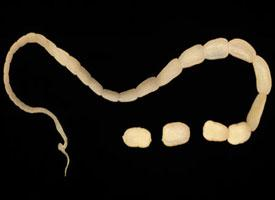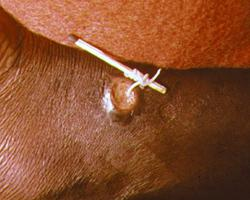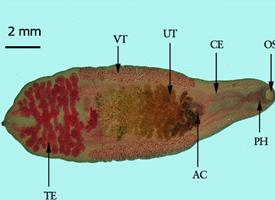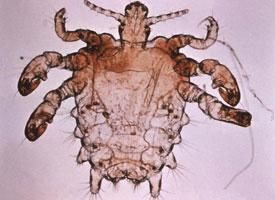
Váhy a míry
| Délka | od 20 do 50 cm |
|---|
Popis zvířete
The Flea tapeworm, scientifically known as Dipylidium caninum, is a parasitic worm that primarily affects dogs and cats but can also infect humans, particularly young children. This parasite is a type of cestode or flatworm, and it belongs to the family Dipylidiidae. The adult form of the tapeworm resides in the small intestine of the host, where it attaches itself to the intestinal wall using its scolex, which is equipped with hooks and suckers for adhesion.The body of Dipylidium caninum is segmented and can grow up to several inches in length, although typically it measures about 20-70 cm. The body is composed of multiple segments called proglottids, which are essentially packages of eggs that are produced by the reproductive organs within each segment. As the tapeworm matures, these egg-filled segments detach from the main body of the worm and are expelled from the host's body through the feces. These segments are recognizable by their unique appearance, often described as resembling grains of rice or cucumber seeds, and they may still be moving when freshly passed.
The life cycle of Dipylidium caninum involves an intermediate host, which is typically a flea. The larvae of the flea ingest the eggs of the tapeworm from the environment, such as from infected feces. Inside the flea, the eggs hatch into larval tapeworms, which remain dormant until the flea is ingested by a definitive host, such as a dog, cat, or even a human. Once inside the definitive host, the larval tapeworms migrate to the intestine, where they attach to the intestinal lining and begin to grow into adult tapeworms, thus completing the cycle.
Infection with Dipylidium caninum, known as dipylidiasis, is often asymptomatic but can cause a range of symptoms, especially in heavy infestations. These symptoms may include abdominal discomfort, diarrhea, and itching around the anus, which can lead to scratching and potential secondary infections. In humans, particularly children, the ingestion of an infected flea typically occurs accidentally, often as a result of close contact with pets.
Diagnosis of dipylidiasis involves the identification of the characteristic proglottid segments in the feces of the infected host. Treatment is generally straightforward and involves the administration of oral anthelmintic medications, which are designed to kill the tapeworms. Prevention of Dipylidium caninum infection is primarily focused on controlling flea populations, as fleas are the necessary intermediate host for the tapeworm's lifecycle. This includes regular flea treatment for pets, maintaining clean living environments, and practicing good hygiene to reduce the risk of accidental ingestion of fleas by humans.
Despite its parasitic nature, Dipylidium caninum is considered to be of relatively low pathogenicity compared to other tapeworms. However, its presence in pets and potential for human infection underscore the importance of routine veterinary care and flea control measures in maintaining the health of both animals and their human companions.
Podobná zvířata
Nové fotografie zvířat
Top 10 zvířat
- Chinese water dragon (Physignathus cocincinus)
- Galápagos tortoise (Geochelone nigra complex)
- Dolphin gull (Leucophaeus scoresbii)
- Japanese macaque (Macaca fuscata)
- Colombian red howler (Alouatta seniculus)
- Sea urchins (Echinoidea)
- Moustached guenon (Cercopithecus cephus)
- Diana monkey (Cercopithecus diana)
- Common reed warbler (Acrocephalus scirpaceus)
- Common house mosquito (Culex pipiens)


